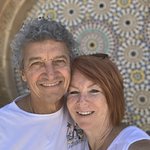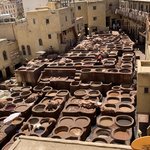Highlights
- Roam the idyllic blue alleyways of Chefchaouen
- Explore the far reaches of the Roman empire at Volubilis
- Get lost in the 1000-year old medieval streets of Fes
- Visit the Hassan II Mosque and the world's tallest minaret in Casablanca
Brief Itinerary
| Day | Highlights | Overnight |
|---|---|---|
| Day 1 | Arrive; Tangier to Chefchaouen | Chefchaouen |
| Day 2 | Roman Ruins of Volubilis, imperial cities of Meknes and Fes | Fes |
| Day 3 | Fes: Exploring the Imperial City and medieval Medina | Fes |
| Day 4 | Fes to Rabat | Rabat |
| Day 5 | Morning in Casablanca; Depart |
Detailed Itinerary
Day 1: Arrival in Tangier, afternoon in Chefchaouen

Welcome to Tangier—the gateway between Europe and Africa! Located close to the south of Spain, visit the medina (old quarter), a café in the hip Zoco Chico square, or take a paseo to enjoy a stroll along the promenade. Or, travel straight on to the blue-washed city of Chefchaouen in the Rif Mountains. Enjoy the scenic route, stopping along the way to hike to the Cascades d'Akchour (Waterfalls of Akchour). Chefchaoen offers endless winding narrow streets and picturesque buildings. Find Plaza Outa el Hammam for a restaurant or café and enjoy a meal as you people watch.
Though non-muslims are not permitted to enter, the Grand Mosque is still worth a visit. From there, explore the nearby kasbah (old fortification) and tour the garden, museum, and some of the old prison cells. Follow a path outside of the city walls to Hotel Atlas and climb to the rooftop to enjoy a panoramic view of the Blue City. For the slightly more athletic, follow the street east to pass over the Ras el Ma Spring and ascend the path (20-30 minutes) until you reach the abandoned white Spanish Mosque. Enjoy one last view over Chefchaouen as the sun sets behind the mountains.
Hike duration: 2-3 hours
Day 2: Roman Ruins of Volubilis, imperial cities of Meknes and Fes

Rise early to snap photos of the people-less streets before leaving for Fes. Stop along the way at the UNESCO protected Volubilis ruins—the Roman's farthest reach in Africa. Wander the complex, exploring merchant homes with still-intact heating systems, temples, and many mosaics in situ. Continue on to the smaller, less busy version of Fes, Meknes, for an introduction to a historic imperial city. The two main points of interest are the Ville Impériale (Imperial City) and the medina. Be sure to visit the Bab al-Mansour gate, the Mausoleum of Moulay Ismail, and the Royal Stables.
Continue on to Fes. With its impressively large (and somewhat confusing) old medina, Fes is a city worth getting lost in. Before venturing into the medina on foot (the largest urban car-free zone in the world), drive uphill to the ruins of the Merenid Tombs for an all-encompassing view of the medieval city. The best time to visit the tombs is around dusk. The muezzin's calls to worship can be heard through the valley as the city lights begin to glow on, adding to the atmosphere. Return to your traditional riad for a warm meal and settle in for the evening.
Chat with a local specialist who can help organize your trip.
Day 3: Fes: Exploring the Imperial City and medieval Medina

Fes is the oldest of the four Imperial Cities in Morocco and perhaps the most interesting and exciting to explore. It has the most complete medina in the Arab world and is relatively untouched since it was founded over 1000 years ago. Often considered the country's cultural capital, it is made up of three parts, two medina quarters, Fes el Bali and Fes el Jdid, and the more modern, French colonial influenced, Ville Nouvelle. Meet your guide and spend a half day learning about the history and culture as you navigate the narrow streets of the medinas.
Start in Fes el Bali at the Bab Boujeloud gate and enter the main thoroughfare of Talâa Kebira. Notice the Spanish and Tunisian influenced architecture as you make your way past shops and souks (markets). One of the most unique sights in the old Medina is the tanneries and Chouara Tannery is no exception. Climb to the rooftop of a nearby leather shop for a better view of the 11th-century stone pots filled with dye and the men at work still using centuries-old techniques.
Next, make your way to the 14th-century Al Attarine Madrasa, a beautiful example of Moroccan architecture and artisanship showcasing intricate zellij tilework. From there, find your way to one of the oldest still-operating universities in the world, Al-Qarawiyyin University (859 CE) next to the Al-Qarawiyyin Mosque. Though the mosque is only open to Muslims, there are a few places where you can glimpse inside to its decorated interior. Cooking enthusiasts may also wish to join a cooking class and learn how to prepare a typical Moroccan meal before retiring for the evening.
Day 4: Fes to Rabat

Take the morning to explore more of Fes. Perhaps visit a local Ceramics and Tilework Collective to watch the tile masters at work, fitting together small pieces of tile to form intricate mosaics. Head west to the imperial city and present-day capital of Rabat, a bustling city with several sights and a rich history.
Explore the medieval fortification of the Chellah Necropolis in the heart of Rabat and wander the Roman and Islamic ruins. Enter into Rabat's original city center through the grand door of the Kasbah des Oudaias. Quietly wander the peaceful white and blue streets. From there, visit the 20th-century Andalusian Gardens and enjoy the serene space away from the crowds. Discover the Hassan Tower, a minaret of the incomplete mosque and Mausoleum of Mohamed V. A 12th-century project that was abandoned, where all that remains today is the red sandstone tower and about 200 columns.
Day 5: Hassan II Mosque in Casablanca; evening departure

Follow the coast south to the modern city of Casablanca. Casablanca's main attraction is the modern and monumental Hassan II Mosque. Inaugurated in 1993, it sits on an outcrop jutting into the Atlantic and offers breathtaking views. It has a 690 feet (210 m) minaret—the tallest structure in Morocco and the tallest minaret in the world. What makes this mosque additionally unique is that it is one of the few mosques in the country non-Muslims are permitted to enter. Join a morning tour and marvel at the fine artisanship: hand-carved stone and wood, intricate marble floor detailing, and gilded ceilings.
If time allows, you may wish to share a drink and a bite to eat at Rick's Café, a restaurant, bar, and café designed to recreate the bar made famous in the movie classic, Casablanca before heading to the airport for your return flight.








